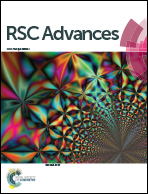Effect of effluent recirculation rate on the performance of anaerobic bio-filter treating coal gasification wastewater under co-digestion conditions
Abstract
In this paper, anaerobic biofilters (AF) were adopted for anaerobic co-digestion of potato starch wastewater (PSW) and coal gasification wastewater (CGW). A modified Gompertz equation was used for the analysis. With a ratio of PSW : CGW at 1 : 1 for the influent, it remarkably improved the removal effect of (chemical oxygen demand) COD and total phenol. With an influent concentration of COD of 2600 mg L−1 and total phenol 200 mg L−1, the effluent COD and total phenol could be decreased to 1100 mg L−1 and 100 mg L−1, respectively. The methane production rate was generally above 260 (mL CH4 per g per d). In order to further enhance the performance of the system, the strategy of effluent recirculation on co-digestion was adopted. The result indicated that under a low effluent recirculation rate of 0.5, concentrations of COD and total phenol in effluent could reach as low as 800 and 70 mg L−1, respectively. Also, the methane production rate was around 300 (mL CH4 per g per d). High-throughput sequencing showed the microbial phyla Bacteroidetes, Chloroflexi, Euryarchaeota, Firmicutes dominanted the system and the abundance variation was observed at different effluent recirculation rates.


 Please wait while we load your content...
Please wait while we load your content...